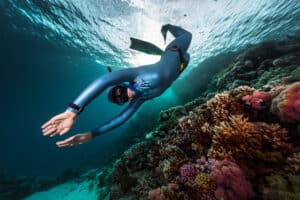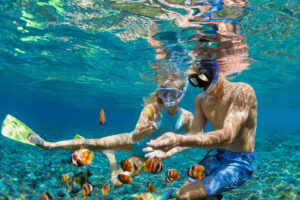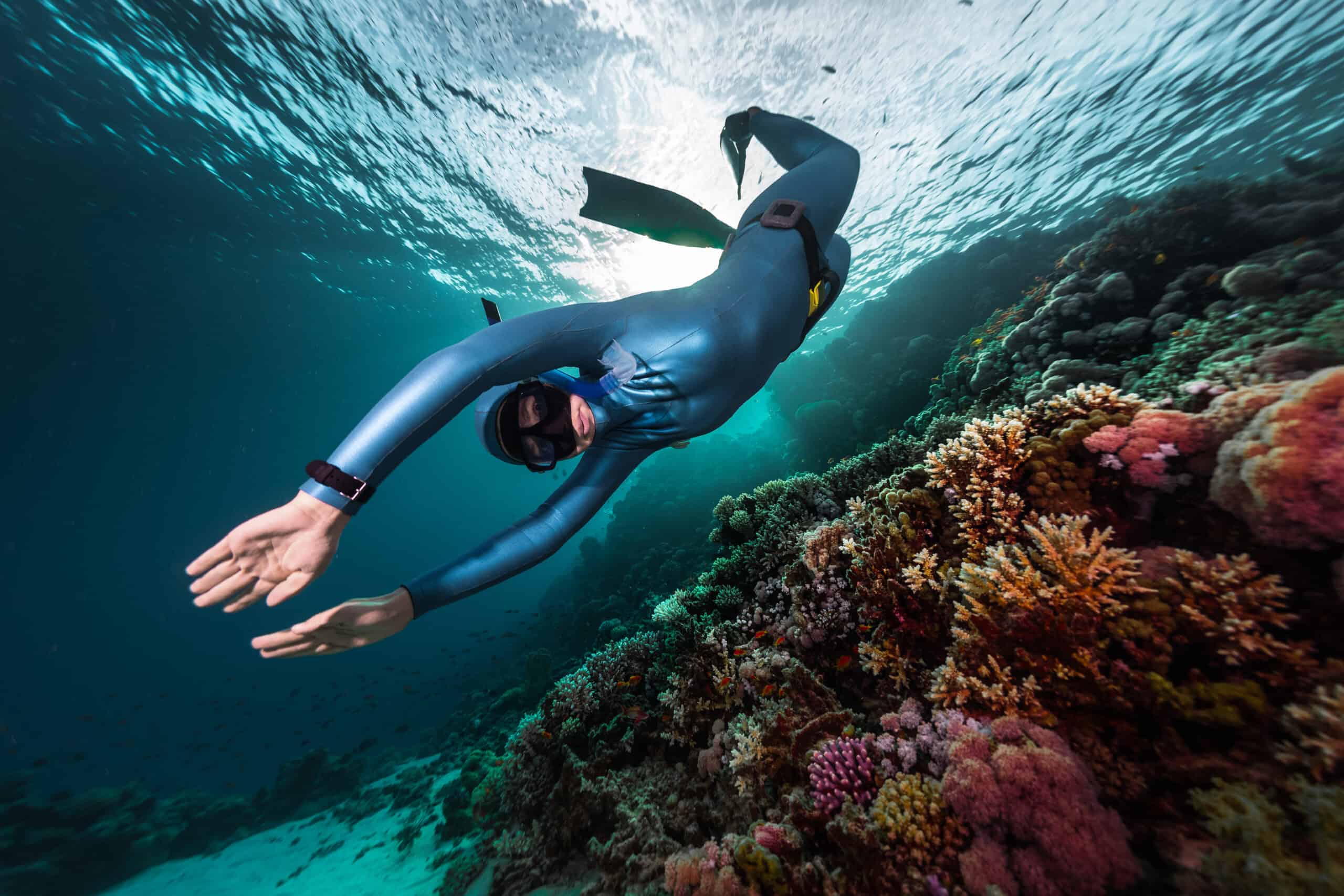*This post may contain affiliate links. As an Amazon Associate we earn from qualifying purchases.
Scuba diving can be a thrilling underwater activity, but not everyone will be just as excited about going. It could be a medical condition, lack of confidence, or simply looking for a more intense excursion that drives you to look for other activities.
Luckily, there are many other ways to enjoy the beauty of the ocean besides a scuba diving session. Some trips would even allow you to go underwater without getting wet!
Check out these alternatives to scuba diving that you can add to your bucket list.
Alternatives to Scuba Diving You Should Try
If, for some reason, you can’t or won’t go scuba diving, here are nine other options to try.
1. Breathing Observation Submersible Scooter (BOSS)
BOSS is a type of excursion where you get to ride on a submersible scooter with a helmet attached to an air tank so that you can breathe underwater. For the divers’ safety, the top of the helmet is attached to the boat via a chord.
Also, there’s no need to worry about the helmet limiting your view of ocean life. Most of its parts are clear, and you can easily move your head around, so a 360-degree view is totally possible.
The best part? You don’t need any kind of training or previous diving experience to get started! However, there’ll be an in-depth orientation at the beginning so that you know what to do when you’re in the water.
If you’re planning to go on a BOSS excursion, don’t forget to bring a comfortable bathing suit and a waterproof camera.
2. Freediving

If you want to experience something more challenging than scuba diving, consider freediving. This activity is also known as breath-hold diving because you go into depths without a breathing apparatus, just pure lung power!
This adventure can be done in saltwater and freshwater, but the main types include:
- Recreational Freediving
- Constant Weight Freediving (CWT or CNF)
- Free Immersion Freediving (FIM)
- Variable Weight Freediving (VWT)
- No Limits Freediving (NLT)
That said, you’ll need to master a couple of pool disciplines for a smooth experience.
The first one is static apnea, which is holding your breath for as long as you can while staying still. The other discipline is called dynamic apnea and is used in competitive freediving with similar principles as static apnea, except, this time, you’re moving.
However, we recommend freediving only if you’ve had sufficient training and are confident underwater without a breathing apparatus. If it’s your first time, it’s best to go with a team or a professional diver to guide you.
Unfortunately, trainers and safety divers may not allow you to go deep diving if you have health problems like coronary artery disease, epilepsy, or asthma triggered by exercise and cold temperatures.
For good measure, visit your trusted physician to make sure that you’re fit enough to go freediving.
3. Helmet Diving
Those who are uncomfortable under extreme depths may opt for helmet diving, which is usually done in relatively shallow waters. In this activity, the diver can breathe normally inside a clear helmet as he walks on the ocean floor.
The diving helmet has weights on the rim so that it remains steady, thus retaining the air inside with an external supply. It also has pads on the shoulders to keep the diver comfortable despite the weight.
Plus, with helmet diving, communication and movement aren’t too restricted. This way, you get a good view of colorful undersea creatures swimming about.
What newbies like best about this scuba alternative is that it doesn’t require complex skills. As long as you don’t have breathing or walking difficulties, you’re qualified to go helmet diving.
For safety reasons, most tours allow only those who are thirteen years old and above.
4. Semi-Submersible Submarine
Going on a semi-submersible submarine, nicknamed semi-sub, is an exciting way to observe marine activity while staying dry. For this, you don’t need to learn how to swim or be at a certain age.
Semi-subs have two sections, the upper and lower floors. The former sticks out of the surface, while the latter stays underwater.
Through the viewing windows, you can marvel at the colorful reefs and fishes while staying comfy inside. In most cases, the semi-sub tour could take about 25 minutes, with a guide giving commentaries along the trip.
There’s no need to bring diving equipment or even a suit for this. Just be in your regular clothes and bring a camera phone for photo souvenirs!
5. Snorkeling
The major difference between scuba diving and snorkeling is the depth. The deepest you can go in this exciting experience is 6 feet, and it usually doesn’t take longer than 30 minutes.
So, if deep-sea diving stresses you out, snorkeling might be more comfortable for you. You’ll just need to make sure that you bring the appropriate gear and suit to make the most out of your trip.
When snorkeling, a snorkel mask helps you see clearly and breathe underwater. However, the tube is usually short, so you need to stay close to the surface so that the free end of the tube sticks out of the water.
There are two types of masks that you can use: the traditional kind, where you breathe through the mouth, and the full-face one, where you can breathe normally through the nose and mouth.
All in all, you have to know, at least, the basics of swimming and diving to go snorkeling. It would also help if you could practice breathing through your mask for an effortless experience.
6. Snuba
You probably know snorkeling and scuba diving, but have you heard about their love child? In essence, snuba diving is the combination of both diving activities. The name says it, after all.
So, where do they differ, and how are they similar?
While snorkeling lets you stay close to the surface, snuba lets you dive a little deeper. Yet, not deeper than 60 feet because then you’ll need a scuba certification.
Snuba diving lets you go as deep as 20 feet while wearing fins, a mask, a weight belt to maintain buoyancy, and a harness for air supply.
Therefore, if you’re having a hard time choosing between scuba diving and snorkeling, you might as well go for scuba diving and have the best of both worlds!
7. Skin Diving
Skin diving is the marriage of two other underwater adventures: snorkeling and freediving.
When you’re skin diving, you spend part of the time at the surface, observing the scenery. Then, you can dive deeper from time to time to get a closer look at marine life and coral reefs that could catch your eye.
Generally, this activity doesn’t require bulky diving equipment because it holds the breath-holding principles of freediving. So, to savor your time skin diving, be sure that you’ve mastered static and dynamic apnea.
There’s no need for a diving suit, either, thus, the name. This is why you’ll often see skin divers only wearing small pieces of bathing suits, swimfins, and snorkel masks.
For a fun and safe skin diving adventure, don’t skimp on preparation and go with a trusted diving team.
8. Mermaiding
Do you want to know what it feels like to live a day in the life of a mermaid? Well, there’s a name for that leisure interest, and it’s called ‘mermaiding.’
This activity gained popularity in the early 2000s, especially among women. They do this by wearing mermaid-like tails and swimming in motions similar to a dolphin’s.
Mermaid tails are usually made of fabric, neoprene, and sequins to mimic scales and latex. Some may also come in silicone or urethane. In principle, the lighter and more stretchy the material, the better.
Unfortunately, basic swimming skills won’t be enough for successful mermaiding. You have to be, at least, a good swimmer, if not an expert.
To become a professional mermaid (which is a legitimate occupation now, by the way), you also need the skills of a freediver. After all, you’re going to need to hold your breath for longer periods at a time. Watch this video about being a professional mermaid.
9. Virtual Diving
Some people aren’t physically capable of going on diving excursions, but it shouldn’t be a hindrance at all.
Thanks to virtual reality, everyone—without exception—can now get a feel for an underwater tour without the need to leave home.
In some cases, it can even double as an educational activity!
The Takeaway
Underwater fun should never be restricted to scuba diving only. That’s why we’ve come up with this list of equally exciting alternatives to scuba diving for you to try on your next trip.
No matter your skill level and interest, there’s always something fun for you to do in the ocean. Just make sure you’re well-equipped, both in gear and skills, to make the most of your well-deserved vacation!

